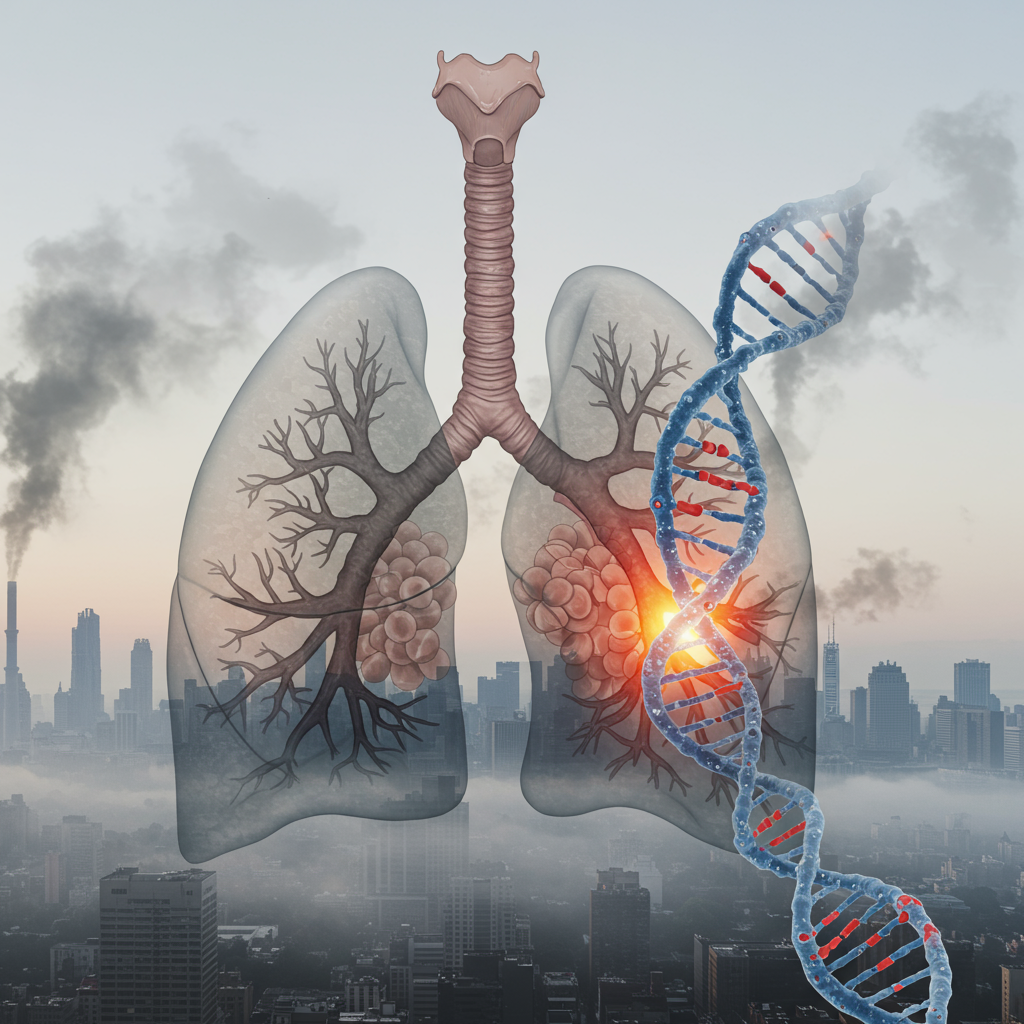Lung cancer remains the leading cause of cancer-related death worldwide. Millions of new cases are diagnosed each year. Historically, tobacco smoking has been the primary driver. However, a concerning trend is emerging. A growing proportion of lung cancer patients have never smoked. This has presented a significant medical mystery. Scientists have been searching for the cause.
A groundbreaking study published in the journal Nature offers a critical answer. Researchers have found a direct genomic link. Exposure to air pollution can cause specific DNA mutations. These mutations are known to drive lung cancer development. This research helps explain why never-smokers are increasingly affected. It highlights air pollution as an urgent global health problem.
The Genomic Evidence Against Air Pollution
The study, part of the extensive Sherlock-Lung investigation, provides compelling evidence. Researchers analyzed the genetic code of lung tumors. They examined samples from 871 never-smokers. These patients were located across four continents: Europe, North America, Africa, and Asia. The team used whole-genome sequencing technology. This allowed them to map the full set of genetic instructions in the tumors.
They compared the genetic data with estimated air pollution levels in the patients’ regions. Satellite and ground-level measurements provided pollution data. The findings were stark. Patients living in areas with higher air pollution had more mutations in their tumors. This included a higher number of “driver mutations.” These mutations actively promote cancer growth. The study established a clear dose-response relationship. Higher pollution exposure meant more mutations.
Molecular Fingerprints: How Pollution Attacks DNA
The research specifically linked fine particulate matter (PM2.5) to genetic damage. These tiny particles are less than 2.5 micrometers in diameter. They are considered among the most dangerous pollutants. They can bypass the body’s natural defenses. The study found a strong association between PM2.5 exposure and mutations in the TP53 gene. This gene plays a critical role in controlling cell growth. Mutations in TP53 are frequently seen in lung cancers. Interestingly, TP53 mutations are also strongly linked to tobacco smoking.
The study revealed that air pollution doesn’t necessarily create unique genetic “signatures.” Instead, it increases the overall load of existing mutational patterns. These patterns are like molecular fingerprints. Higher pollution levels amplified signatures already associated with factors like tobacco smoking and aging. For instance, never-smokers in more polluted environments showed nearly a four-fold increase in a smoking-related signature. This suggests pollution causes similar types of DNA damage.
Beyond Mutations: Telomeres Tell a Story
The genetic damage wasn’t the only sign of pollution’s impact. Researchers also examined telomeres. Telomeres are protective caps at the ends of chromosomes. They are often compared to the plastic tips on shoelaces. Telomeres naturally shorten with age. Premature shortening is a sign of accelerated cellular aging. It also indicates more rapid cell division. Uncontrolled cell division is a hallmark of cancer development.
The study found that individuals exposed to greater air pollution had shorter telomeres. This reinforces the idea that pollution is causing widespread cellular stress. It appears to be pushing cells towards a state ripe for cancer growth. This telomere finding adds another layer to the genomic evidence. It suggests multiple pathways by which pollution promotes malignancy.
The Growing Problem in Never-Smokers
With smoking rates declining in many Western nations, the proportion of lung cancer cases in never-smokers is rising. This group now accounts for an estimated 10% to 25% of all lung cancer diagnoses. Almost all these cases are a type called adenocarcinoma. This rise in never-smoker cases is a major public health concern.
Lung cancer remains the deadliest cancer globally. Approximately 2.5 million new cases are diagnosed worldwide each year. Over a million deaths occur in China. Factors like smoking, air pollution, and other environmental contaminants contribute there. The study found that the highest rates of pollution-attributable adenocarcinoma were in East Asia. Lung cancer disproportionately affects women in this region. It also affects those of Asian ancestry. While UK cases from pollution are lower in number, they are still significant. Air pollution is estimated to cause over 1,100 new diagnoses of the main lung cancer type in the UK annually. Experts call this finding “alarming.”
Comparing Risks: Pollution and Secondhand Smoke
The study also investigated the role of secondhand tobacco smoke. While secondhand smoke is a known risk factor, its genomic impact seemed less pronounced in this research. Tumors from those exposed to secondhand smoke showed only a slight increase in mutations. They also had shorter telomeres. However, they lacked the distinct, amplified mutational signatures seen with direct air pollution exposure.
This does not mean secondhand smoke is safe. It is a significant health hazard. The study suggests that the genomic tools used might be less sensitive to its effects. However, the findings strongly position fine particulate air pollution as a major driver of lung cancer mutations in never-smokers. The mutagenic effect appeared much stronger for pollution at a genomic level.
Other Environmental Factors and New Mysteries
Beyond air pollution, the research identified another environmental risk. Certain traditional Chinese herbal medicines contain aristolochic acid. This substance is a known carcinogen. The study found a specific mutational signature linked to this acid. This signature was observed almost exclusively in never-smoker lung cancer cases from Taiwan. Aristolochic acid was previously linked to other cancers (like bladder and kidney). This is potentially the first genomic evidence linking it to lung cancer. This finding presents a clear public health opportunity. Avoiding these specific herbal medicines could prevent cancer.
Furthermore, the study uncovered a completely new mystery. A distinct mutational signature was present in most never-smoker lung cancers. However, it was entirely absent in smokers’ tumors. The cause of this new signature is currently unknown. It did not correlate with air pollution levels or other identified exposures. This discovery opens a new avenue for research. It highlights the complex causes of lung cancer in people who have never smoked.
Unraveling the Mechanism of Harm
Researchers are still refining the exact mechanism. One proposed theory involves PM2.5 particles. These particles are inhaled deep into the lungs. They may directly cause DNA damage in lung cells. Living in highly polluted environments could also accelerate cell division. More cell divisions mean more chances for errors or mutations to occur. This combination of damage and increased cellular activity could drive tumor development. Previous research supports this idea. A meta-analysis of 17 studies found a troubling link. An increase in PM2.5 exposure raised lung cancer risk by eight percent. It also increased the risk of dying from the disease by eleven percent.
Implications for Public Health and Future Research
The findings underscore the urgent need to address air pollution globally. As smoking declines, pollution is becoming a more significant driver of lung cancer. This is particularly true for populations not traditionally seen as high risk, like never-smokers. The World Health Organization estimates pollution causes millions of premature deaths worldwide. This research adds lung cancer in never-smokers to that heavy toll.
Identifying specific environmental culprits like PM2.5 and aristolochic acid is crucial. It allows for targeted prevention strategies. Reducing air pollution levels through policy and infrastructure changes is paramount. Raising awareness about the risks of certain herbal medicines is also vital, especially in affected regions like Taiwan.
The researchers plan to expand their investigation. They aim to include more global regions. They will also explore other potential risk factors. These include marijuana use, e-cigarettes, radon, and asbestos. Gathering more detailed individual and local pollution data will also be key. This ongoing work is essential to fully understand and combat lung cancer in never-smokers. It is an increasingly complex and global challenge.
Frequently Asked Questions
How does air pollution cause DNA mutations linked to lung cancer?
Fine particulate matter (PM2.5) is a key culprit. These tiny particles can reach deep into the lungs. The study suggests PM2.5 causes direct DNA damage in lung cells. It also potentially speeds up cell division. This increases the chance of random mutations. These mutations can include changes in genes like TP53. Such changes are known drivers of cancer growth.
Which specific air pollutant is most strongly linked to mutations in never-smokers?
The study highlighted fine particulate matter (PM2.5). These particles are smaller than 2.5 micrometers. They are strongly associated with increased cancer-driving DNA mutations. The research found a direct link between higher PM2.5 levels and more mutations in never-smokers’ lung tumors, particularly in the TP53 gene.
Does this study mean secondhand smoke is not a risk for never-smokers?
No, secondhand smoke is still a known health risk. This study found that secondhand smoke exposure showed a weaker genomic link compared to air pollution. Tumors from those exposed to secondhand smoke had only a slight increase in mutations and shorter telomeres. This doesn’t negate its harm but suggests air pollution might have a more pronounced mutagenic effect at the genomic level based on current tools.
Conclusion
The link between air pollution and lung cancer in never-smokers is now backed by strong genomic evidence. This study in Nature reveals how pollution drives cancer through DNA mutations. It specifically highlights the role of PM2.5 particles and their effect on critical genes like TP53. The findings explain the worrying rise in never-smoker cases globally. They underscore the need for urgent action on air quality. The identification of other risks, like certain herbal medicines, offers new prevention avenues. Continued research is vital to combat this complex and growing global health threat.



